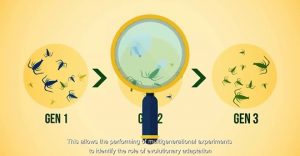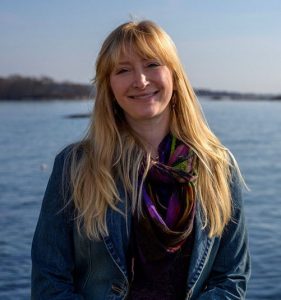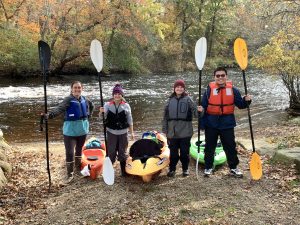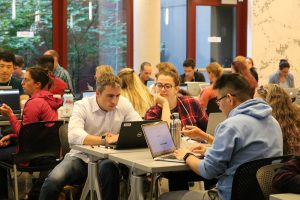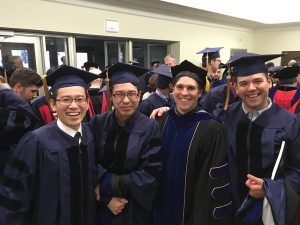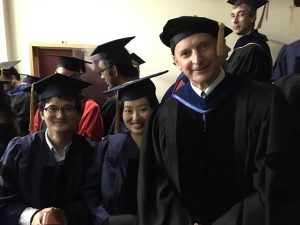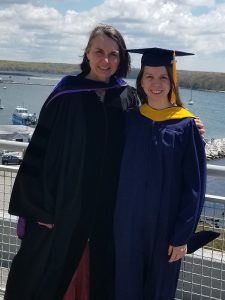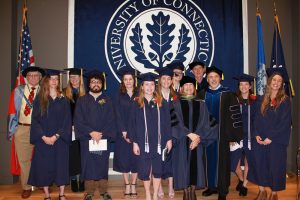Researchers at UConn and U Vermont carry out experimental evolution studies to assess the scope for evolution of marine zooplankton under greenhouse (high temperature and high CO2) conditions. They explain their approach in a lay-audience video (https://www.youtube.com/watch?v=YrI2188-ejM&feature=youtu.be).
Author: Schuler, Debra
Siedlecki featured in UConn Today
Professor Samantha Siedlecki was recently featured in UConn Today, a wide audience publication produced by the university’s Office of Communications. The article highlights her background and cutting-edge research projects.
https://today.uconn.edu/2019/11/meet-researcher-samantha-siedlecki-marine-sciences/
Conservation Physiology publishes DMS study on early life CO2 sensitivity of Northern sand lance
21 November 2019. Members of the Evolutionary Fish Ecology lab (befel.marinesciences.uconn.edu) are excited to announce that Conservation Physiology has just published our ground-breaking research on the unusual, high sensitivity of Northern sand lance embryos to acidification and warming. Dr. Chris Murray, who recently graduated from UConn with his Ph.D. and now pursues his post-doctoral research at the University of Washington, is the lead author of this study, which was funded by a Northeast Regional SeaGrant project and conducted in collaboration with NOAA colleagues from Stellwagen Bank National Marine Sanctuary.
Our study suggests that organisms that develop slowly in offshore, temperate/subpolar habitats are likely most vulnerable to the combined effects of increasing temperature and acidification in the ocean.
Murray, C.S.*, Wiley, D., and Baumann, H. (2019) High sensitivity of a keystone forage fish to elevated CO2 and temperature. Conservation Physiology 7:1-12
DOI: 10.1093/conphys/coz084
Just another day at the office
Researchers from Marine Sciences at the 14th ICMGP in Krakow, Poland
The bi-annual week-long conference, International Conference on Mercury as a Global Pollutant (ICMGP) was held in Krakow in Poland in September. During this conference academic researchers, consultants, policy makers and companies that specialize in mercury analytical instrumentation showcased recent developments in their specific areas. Graduate and undergraduate students and faculty from the Department of Marine Sciences (listed below) presented their findings on mercury in atmosphere and marine environment and enlarged their professional networks. The Distinguished Professor (emeritus) William Fitzgerald, who has pioneered the field of Marine Mercury in the Department of Marine Sciences here at UConn, was also among the attendees (seen on one of the photographs with his former student and current UConn faculty, Prof. Robert Mason).
Dr. Robert Mason, Professor
Dr. Zofia Baumann, Assistant Research Professor
Mackenzie Blanusa, Undergraduate
Gunnar Hansen, Ph.D student
Yipeng He, Ph.D student
Wesley Huffman, Ph.D student
Patricia Myer, Ph.D student
Zooplankton vulnerability to Warming: Go with the Flow, But It Is Complicated
Work from Professor Hans Dam’s laboratory (https://marinesciences.uconn.edu/faculty/dam/) led by Ph.D. student, Matthew Sasaki (https://marinesciences.uconn.edu/students/sasaki/) shows that zooplankton vulnerability to warming depends on a complex interplay of population dispersion, local adaptation, and phenotypic plasticity. Thus predicting the fate of the oceanic biota to climate change is a multifaceted issue that requires careful integration of oceanography, ecology, and evolution.
The work (https://onlinelibrary.wiley.com/doi/abs/10.1111/gcb.14811) is published in the prestigious journal Global Change Biology, and is also highlighted in a lay-audience article (https://today.uconn.edu/2019/09/ocean-dweller-ability-respond-warming-waters-location/?utm_source=listserv&utm_medium=email&utm_campaign=daily&utm_content=uconn-today) in the online Magazine, UConn Today.
DMS graduate student participates in Oceanhackweek 2019
For the first week of the semester, PhD student Molly James participated in the second annual Oceanhackweek, hosted by the eScience Institute at University of Washington in Seattle, WA. Oceanhackweek brings together a diverse group of people at all career stages and at every level of coding experience. The organizers state it best: “In contrast to conventional academic conferences or workshops, hackweeks are intensive and interactive, facilitated by three core components: tutorials on state-of-the-art methodologies, peer-learning, and on-site project work in a collaborative environment.”
Molly learned about and completed tutorials on data science tools in the oceanographic community. The topics of the tutorials included Github, cloud computing, Jupyter notebooks, python visualization tools, machine learning, and other open source resources. She also organized a “hack” project that addressed the issue of co-locating data from disparate data servers, in order to either validate or supplement a data set with another. Her group decided to approach this task by looking at over 30 ERDDAP servers hosted by different organizations. The group utilized Jupyter notebooks and python packages to create a user-friendly search tool that queries these multiple servers simultaneously. Despite having less than 5 days to work together, the team produced a beta-version of the search tool by the end of Oceanhackweek. The documentation and code development is available on their team Github code repository.
Other interested scientists of all levels should keep an eye out for the application to Oceanhackweek 2020! It is a great opportunity to build community and confidence in computing skills.
Ann Bucklin presented with ICES Outstanding Achievement Award
Molecular biologist Ann Bucklin presented with Outstanding Achievement Award during the opening ceremony of ICES Annual Science Conference in Gothenburg, Sweden.
Ann Bucklin has made significant contributions to ICES over a long career marked by a continued high level of commitment to excellence in science, research, and training. For more than 20 years, Ann has been a member of ICES community and has had an ongoing impact in the field of marine science over this time.
Her contributions were recognized at the opening of ICES Annual Science Conference 2019 in Gothenburg, Sweden.
Read the complete article here: https://www.ices.dk/news-and-events/news-archive/news/Pages/An-outstanding-role-model-Ann-Bucklin-presented-with-Outstanding-Achievement-Award.aspx
Fishing changes silverside genes
Over recent decades, many commercially harvested fish have grown slower and matured earlier, which can translate into lower yields. Scientists have long suspected that rapid evolutionary change in fish caused by intense harvest pressure is the culprit.
Now, for the first time, researchers have unraveled genome-wide changes that prompted by fisheries – changes that previously had been invisible, according to a study published in Science by a team of researchers including Hannes Baumann, UConn assistant professor of Marine Sciences, who collaborated with researchers at Cornell University, the University of Oregon, the National Marine Fisheries Service, and Stanford University.
In unprecedented detail, the study shows sweeping genetic changes and how quickly those changes occur in fish populations extensively harvested by humans, says Baumann.
“Most people think of evolution as a very slow process that unfolds over millennial time scales, but evolution can, in fact, happen very quickly,” said lead author Nina Overgaard Therkildsen, Cornell assistant professor of conservation genomics in the Department of Natural Resources.
In heavily exploited fish stocks, fishing almost always targets the largest individuals. “Slower-growing fish will be smaller and escape the nets better, thereby having a higher chance of passing their genes on to the next generations. This way, fishing can cause rapid evolutionary change in growth rates and other traits,” said Therkildsen. “We see many indications of this effect in wild fish stocks, but no one has known what the underlying genetic changes were.”
Therkildsen and her colleagues took advantage of an influential experiment published back in 2002. Six populations of Atlantic silversides, a fish that grows no bigger than 6 inches in length, had been subjected to intense harvesting in the lab. In two populations, the largest individuals were removed; in another two populations, the smallest individuals were removed; and in the final two populations, the fishing was random with respect to size.
After only four generations, these different harvest regimes had led to evolution of an almost two-fold difference in adult size between the groups. Therkildsen and her team sequenced the full genome of almost 900 of these fish to examine the DNA-level changes responsible for these striking shifts.
The team identified hundreds of different genes across the genome that changed consistently between populations selected for fast and slow growth. They also observed large linked-blocks of genes that changed in concert, dramatically shifting the frequencies of hundreds of genes all at the same time.
Surprisingly, these large shifts only happened in some of the populations, according to the new paper. This means that there were multiple genomic solutions for the fish in this experiment to get either larger or smaller.
“Some of these changes are easier to reverse than others, so to predict the impacts of fisheries-induced evolution, it is not enough to track growth rates alone, we need to monitor changes at the genomic level,” said Therkildsen.
When the experiment was originally conducted nearly two decades ago by co-authors David Conover, professor of biology at the University of Oregon, and Stephan Munch of the National Marine Fisheries Service, the tools to study the genomic basis of the rapid fisheries-induced evolution they observed were not available. Fortunately, Conover and Munch had the foresight to store the samples in a freezer, making it possible to now return – armed with modern DNA sequencing tools – and reveal the underlying genomic shifts.
Research like this can assess human impacts, and improve humanity’s understanding of “the speed, consequences and reversibility of complex adaptations as we continue to sculpt the evolutionary trajectories of the species around us,” Therkildsen said.
“What’s most fascinating about this is that life can find different genetic ways to achieve the same result. In this study, two experimental populations evolved smaller body size in response to the selective removal of the largest fish, which is what most trawl fisheries do. However, only by looking at the genetic level we demonstrated that these two experimental populations evolved via two completely different genetic paths,” says Baumann.
The good news for the Atlantic silversides is that the fisheries selection was able to tap into the large reservoir of genetic variation that exists across the natural range of this species from Florida into Canada, said Therkildsen: “That genetic bank fueled rapid adaptation in the face of strong fishing pressure. Similar responses may occur in response to climate-induced shifts in other species with large genetic variability.”
“Scientists have coined the term Anthropocene in recognition of the all-pervasive human alteration of the earth’s climate, oceans, and land. No matter how ‘pristine’ a piece of nature may look to us at first glance, examine it thoroughly enough and you will find a trace of human in it. Take a cup of water from the middle of Pacific Ocean and a handful of sand from a ‘pristine’ beach – and you will find little plastic particles under the microscope,” says Baumann. “The parallel to this study is that the all-pervasive human meddling in our planet’s affairs now undeniably reached the genetic make-up of its organisms. Today’s fishes may superficially look the same as always, but their genes are not. They bear witness to human alteration.”
In addition to Baumann, Therkildsen, Conover, and Munch, co-authors included former Cornell postdoctoral researcher Aryn P. Wilder, now a researcher at San Diego Zoo Institute for Conservation Research; and Stephen R. Palumbi, Stanford University.
This work was funded by the National Science Foundation.
Congratulations 2019 Graduates!
Yan Jia, Qiang Sun, Prof. Michael Whitney, and Steven Deignan-Schmidt at the doctoral commencement ceremony.
Gihong Park, Youngmi Shin, and Prof. James O’Donnell at the doctoral commencement ceremony.
Christopher Murray after the doctoral commencement ceremony.
Prof. Penny Vlahos and Allison Byrd after the master’s commencement ceremony.
Marine Sciences graduates and faculty at the Senior Recognition Ceremony at Avery Point on May 10, 2019.
